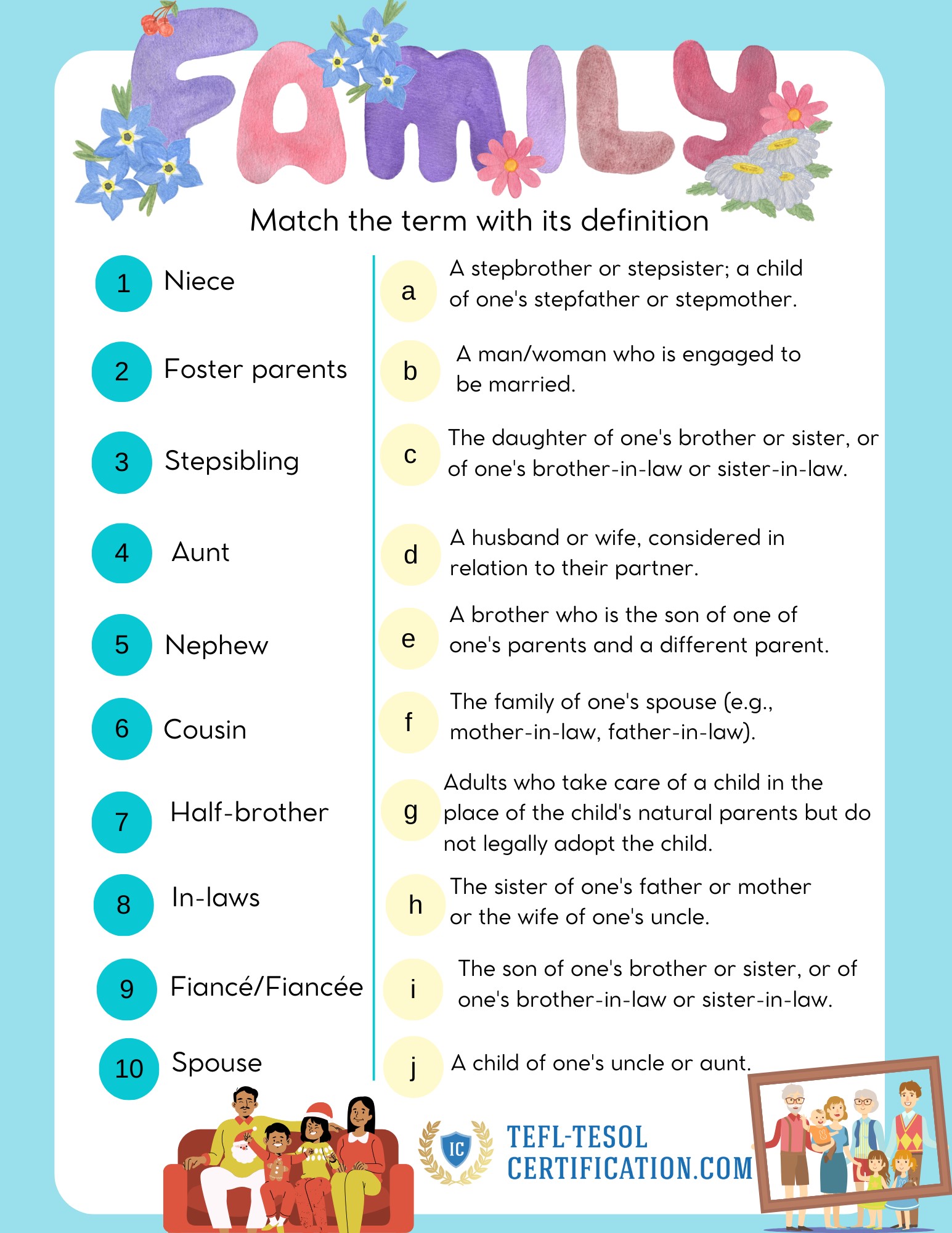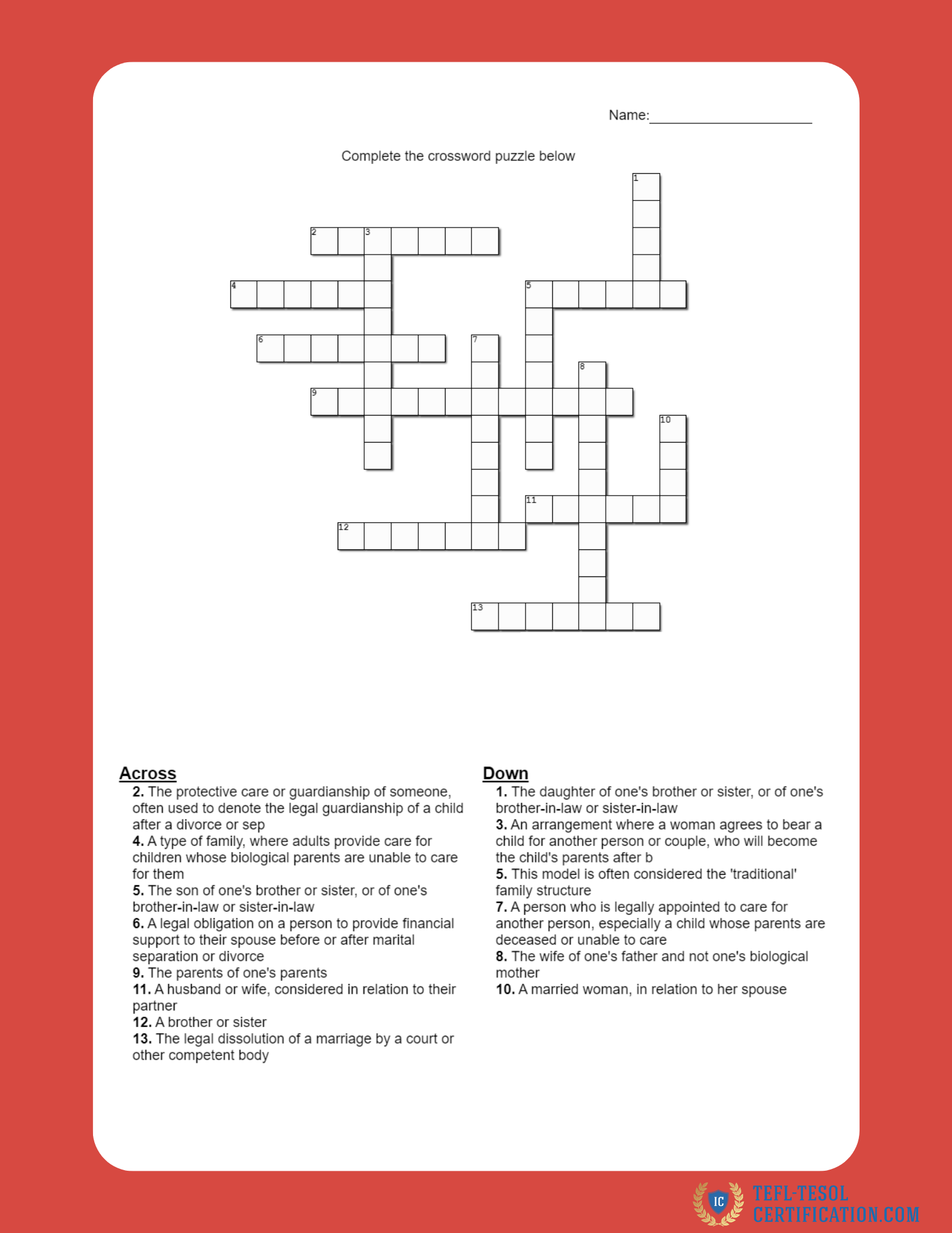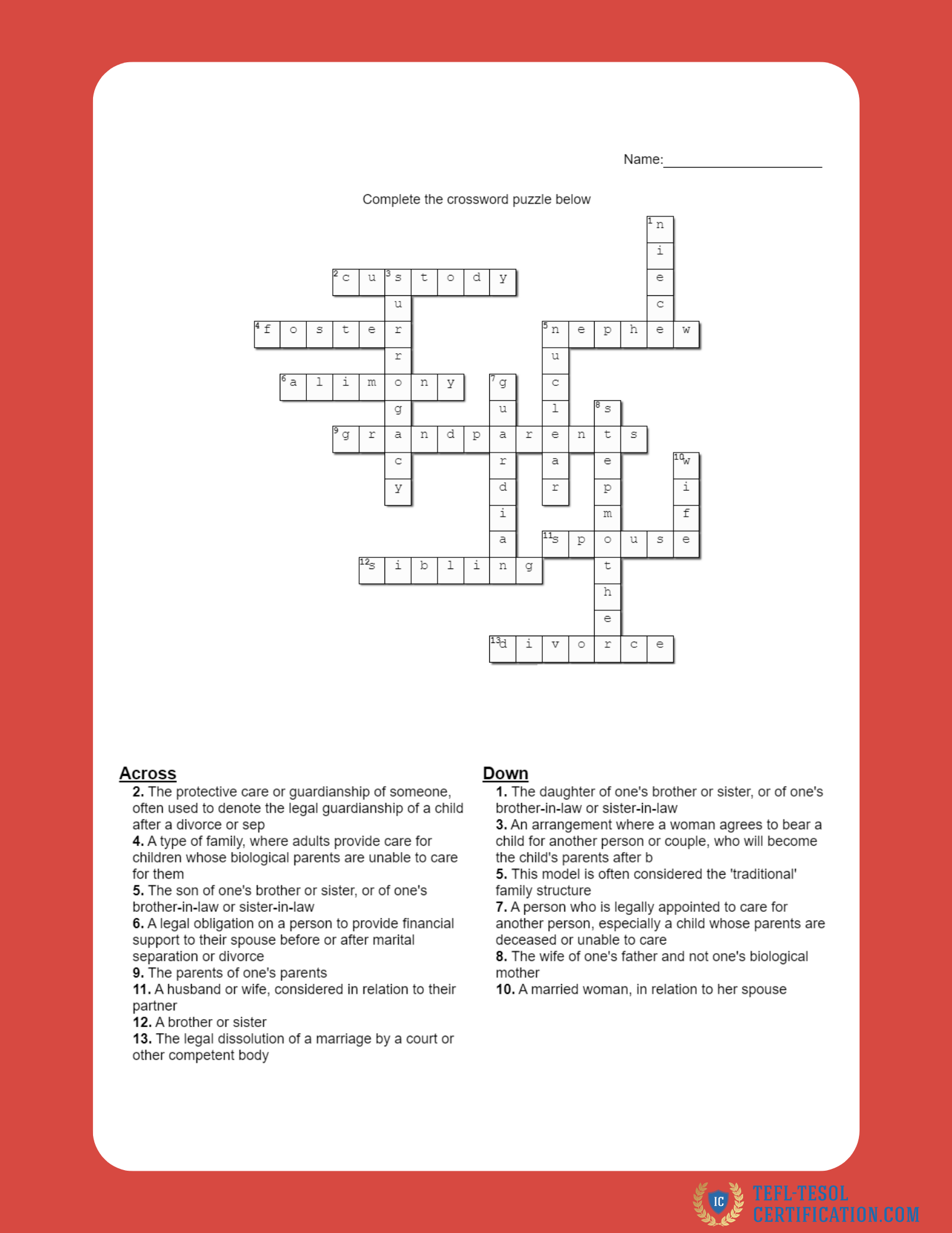And start earning money 💸 by teaching English in your own country, abroad, or online from anywhere on the planet! 🎁 Gifts and bonuses: professional support from your personal coach 🧑🏫 and job placement assistant 💼.
Table of contents
Teaching about the family in an English class is not only a fundamental requirement but also a wonderful opportunity to expand vocabulary and engage students in discussions about the diversity and dynamics of modern families. It's possible that some students might already be familiar with basic family-related vocabulary. Therefore, it is essential to introduce extended knowledge on this topic. Here is a comprehensive lesson plan that explores various aspects of families, including types of modern families, such as nuclear and blended families, along with terms related to marriage, common-law partners, divorce, and adoption. Ensure students understand that this lesson will offer new insights for everyone, even those who already know basic terms like mother, father, sister, and brother.
To fully convey the benefits of the lesson, it is crucial to set clear objectives that align with the main goals of the course in which your students are enrolled.
Lesson Objectives may be:
- Expand vocabulary related to family members and family dynamics.
- Explore the concept of different types of modern families.
- Engage in discussions about family-related subjects like marriage, divorce, and adoption.
- Develop critical thinking skills through riddles and family tree activities.
Start with an introduction to Family Vocabulary
Activity: Begin with a brainstorming session where students name all the family-related words they know.
Handout: Match family member with a definition.
Complete this task as a whole class.

Ask students which terms were new or unfamiliar to them, discuss the answers, and briefly go through some additional vocabulary.
A comprehensive list of family member vocabulary along with their definitions:
- Mother: A woman in relation to her child or children.
- Father: A man in relation to his child or children.
- Parent: A mother or father of a child.
- Child (Plural: Children): A son or daughter of any age.
- Sibling: A brother or sister.
- Brother: A boy or man who has one or both of the same parents as another person.
- Sister: A girl or woman who has one or both of the same parents as another person.
- Grandmother: The mother of one's father or mother.
- Grandfather: The father of one's father or mother.
- Grandparents: The parents of one's parents.
- Grandchild (Plural: Grandchildren): A child of one's son or daughter.
- Aunt: The sister of one's father or mother or the wife of one's uncle.
- Uncle: The brother of one's father or mother or the husband of one's aunt.
- Niece: The daughter of one's brother or sister, or of one's brother-in-law or sister-in-law.
- Nephew: The son of one's brother or sister, or of one's brother-in-law or sister-in-law.
- Cousin: A child of one's uncle or aunt.
- Stepmother: The wife of one's father and not one's biological mother.
- Stepfather: The husband of one's mother and not one's biological father.
- Stepchild (Plural: Stepchildren): A child of one's stepfather or stepmother.
- Stepsibling: A stepbrother or stepsister; a child of one's stepfather or stepmother.
- Stepbrother: A son of one's stepfather or stepmother.
- Stepsister: A daughter of one's stepfather or stepmother.
- Half-brother: A brother who is the son of one of one's parents and a different parent.
- Half-sister: A sister who is the daughter of one of one's parents and a different parent.
- Foster parents: Adults who take care of a child in the place of the child's natural parents but do not legally adopt the child.
- Foster child: A child who is raised by foster parents.
- Guardian: A person who is legally appointed to care for another person, especially a child whose parents are deceased or unable to care for them.
- In-laws: The family of one's spouse (e.g., mother-in-law, father-in-law).
- Spouse: A husband or wife, considered in relation to their partner.
- Husband: A married man, in relation to his spouse.
- Wife: A married woman, in relation to her spouse.
- Partner: A person with whom one lives and is romantically involved.
- Fiancé/Fiancée: A man/woman who is engaged to be married.
- Significant Other: A person with whom someone has a romantic or sexual relationship that is important.
Next step is discussion
Lead a conversation about the different types of families (nuclear, single parent, blended, extended, same-sex parents, child-free couples, etc.). Highlight the diversity and inclusivity of modern family structures.
A list of some common types of modern families:
- Nuclear Family: Traditionally consisting of a mother, father, and their biological children. This model is often considered the 'traditional' family structure.
- Single-Parent Family: A family headed by a single parent (mother or father) who takes care of the children on their own, often due to divorce, death of a partner, or by choice.
- Blended Family: Also known as a stepfamily, this type includes parents who have remarried, bringing children from previous relationships together under one roof.
- Extended Family: This family type extends beyond the nuclear family, including grandparents, aunts, uncles, and cousins living in close proximity or under the same roof.
- Childfree Family: Couples who choose not to have children. This family form focuses on the partnership between the couple, without the presence of offspring.
- Same-Sex Parents Family: Families headed by same-sex couples, who may have children through adoption, surrogacy, artificial insemination, or from previous heterosexual relationships.
- Adoptive Family: A family where one or more children have been adopted. The parents may or may not have biological children of their own.
- Foster Family: A temporary arrangement where adults provide care for children whose biological parents are unable to care for them. This arrangement can sometimes lead to adoption.
- Grandparent Family: Families where grandparents are the primary caregivers of their grandchildren, often due to the absence or incapacity of the biological parents.
- Co-Parenting Family: This arrangement involves separated or divorced parents jointly raising their children, sharing responsibilities even if they are not romantically involved.
- Communal/Group Family: Groups of individuals, not necessarily related, who choose to live together and share responsibilities, resources, and childcare.
- Transnational Family: Families where members live in different countries, often due to work or migration, but maintain close emotional and financial ties.
These types illustrate the evolving nature of family structures, showing how family dynamics can vary widely in contemporary society. Each type brings its unique set of dynamics, challenges, and strengths.
Activity: Students can interview each other about their family structures to understand the diversity within their own class.
Guided Discussion: Address sensitive topics like divorce, adoption, and other family-established processes. Ensure a safe and respectful environment for discussion. Present vocabulary and examples. Ask students to create their examples with the given vocabulary.
A list of family-related situations and processes along with their definitions and examples:
- Divorce: The legal dissolution of a marriage by a court or other competent body.
- Example: "After a decade of marriage, they decided to get a divorce due to irreconcilable differences."
- Adoption: The process of legally taking another's child into one's family to raise as one's own.
- Example: "They chose to grow their family through adoption and welcomed a child from another country."
- Common-Law Partners: A couple living together in a relationship akin to marriage but without being formally married.
- Example: "Although not legally married, they have lived as common-law partners for over seven years."
- Stepfamily: A family where at least one parent has children that are not genetically related to the other spouse or partner.
- Example: "Her stepfamily includes two stepbrothers from her father's previous marriage."
- Foster Care: A system in which a minor is placed into a ward, group home, or private home of a state-certified caregiver.
- Example: "He spent his childhood in foster care before being adopted by his forever family."
- Custody: The protective care or guardianship of someone, often used to denote the legal guardianship of a child after a divorce or separation.
- Example: "They went to court to determine the custody arrangement for their children."
- Alimony: A legal obligation on a person to provide financial support to their spouse before or after marital separation or divorce.
- Example: "She was awarded alimony to help maintain her standard of living after the divorce."
- Child Support: Financial support paid by a parent to help support a child or children of whom they do not have full custody.
- Example: "He pays child support to assist with the expenses of raising their two children."
- Paternity Test: A test to determine the father of a child.
- Example: "He requested a paternity test to confirm his biological relationship with the child."
- Surrogacy: An arrangement where a woman agrees to bear a child for another person or couple, who will become the child's parents after birth.
- Example: "Due to medical reasons, they opted for surrogacy to have their first child."
- Maternity Leave: A period of absence from work granted to a mother before and after the birth of her child.
- Example: "She's taking maternity leave for three months to care for her newborn baby."
- Paternity Leave: A period of absence from work granted to a father after or shortly before the birth of his child.
- Example: "He decided to take paternity leave to be with his partner and their new baby during the first few weeks."
- Annulment: A legal procedure for declaring a marriage null and void.
- Example: "They got an annulment, as the marriage was considered invalid due to certain legal reasons."
- Legal Guardian: A person who has the legal authority to care for the personal and property interests of another person.
- Example: "Her aunt became her legal guardian after her parents passed away."
Case Study: Present hypothetical family scenarios and encourage students to discuss them, focusing on the vocabulary and cultural aspects.
Conclusion and Reflection
Group Discussion: Reflect on what was learned about the diversity of families and the importance of understanding and respecting different family dynamics.
Feedback Session: Ask for students' feedback on the lesson and activities.
Encourage students to spend most of the lesson time speaking and improving their communicative skills. You may assign writing tasks as a homework.
For example, Family-Related Crossword.


Or Riddles:
Here are 10 family-related riddles designed for students to guess the family member being described:
- Riddle: "I am the one who gave you life, but we will never have the same voice. Who am I?"
- Answer: Mother
- Riddle: "I am not your father, but I am a man in your family. I am your mother's brother. Who am I?"
- Answer: Uncle
- Riddle: "You might find me older or younger, but I'm always at your level. We share the same parents, but we are not twins. Who am I?"
- Answer: Sibling (Brother or Sister)
- Riddle: "I am related to you, but I am not your child. Your mother is my grandmother. Who am I?"
- Answer: Niece or Nephew
- Riddle: "I am the father of your father, but not your father. Who am I?"
- Answer: Grandfather
- Riddle: "I am married to your child, but I am not your child. Who am I?"
- Answer: Son-in-law or Daughter-in-law
- Riddle: "I am your child's child, but not your child. Who am I?"
- Answer: Grandchild
- Riddle: "You may find me once or twice in your family tree, a partner of a parent, but not the one who gave birth to thee. Who am I?"
- Answer: Stepparent (Stepmother or Stepfather)
- Riddle: "I share one parent with you but not the other. Together we're half, but still full of love. Who am I?"
- Answer: Half-sibling (Half-brother or Half-sister)
- Riddle: "I have no biological tie to you, but I care for you like my own. Not by birth, but by choice, in our family, you've grown. Who am I?"
- Answer: Foster parent or Adoptive parent
💡 Unlock the secrets to doubling your teaching income with our exclusive checklist! 🎯 This checklist is designed for English teachers who want to 📈 attract more students and 🔥 keep them engaged for the long term.
Family Tree Project is a classical task to complete
Creative Assignment: Students create their own family tree, which can be real or fictional, to practice the vocabulary. Encourage creativity and diversity in their family tree designs.
Preparing presentation for the next class: Students present their family trees to the class, describing each member and their relationship to each other.
Additionally, assign a family-topic video as a listening task to be completed. Inform the students that they should be prepared to answer questions related to this video in the next lesson.
Final Thoughts
This lesson plan aims to be inclusive and sensitive to the various forms of families that exist in our society. By exploring these topics, students not only learn English vocabulary but also develop a deeper understanding and respect for the diversity of family structures. Interactive activities like crosswords and family tree projects make the learning process engaging and enjoyable.

York Fern
An English instructor with 12+ years of experience. I work for an online school and travel the world, teaching students from various countries, leveraging my TEFL/TESOL certification. Seeing the world's oceans, mountains, and cities with my own eyes has given me a profound appreciation for the importance of quality education and international communication.
and start earning by teaching English in your country, abroad, or online from anywhere in the world! Order the course with a 50% discount 💸 and receive as a gift the support of a personal coach 👨🏫 and job placement assistant! 🎁🚀 Hurry, limited spots available! 🏃♂️💨
💡 Unlock the secrets to doubling your teaching income with our exclusive checklist! 🎯 This checklist is designed for English teachers who want to 📈 attract more students and 🔥 keep them engaged for the long term.
🚀 More students, 💰 higher income, 🌍 complete freedom! ✅ 112 verified platforms with top rates ⏳ Flexible schedule – work whenever and as much as you want 🎯 Simple requirements – start earning right away 💎 Boost your career and income by teaching students worldwide!
choose us?




